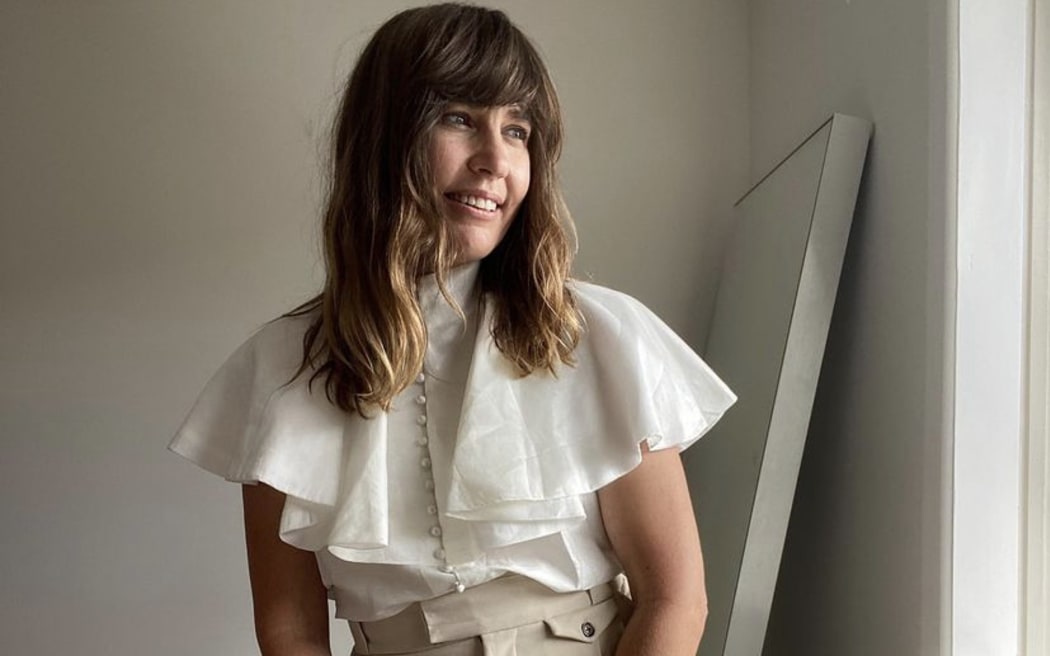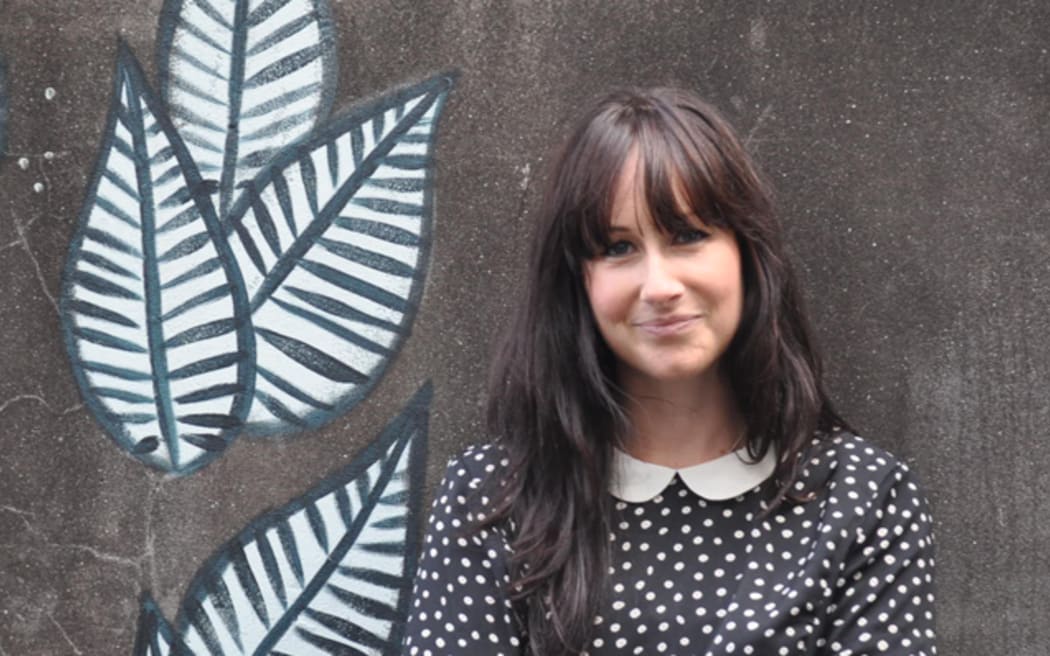By Carolyn Enting*
Sara Kupa, the founder of online preloved and vintage store Secret Threads, wearing New Zealand vintage. She is also co-founder of Christchurch-based sustainable styling service Malone.
Photo: Supplied
Once a haven for budget-conscious shoppers and vintage enthusiasts, op-shopping is facing new challenges: rising prices and an oversupply of fast fashion.
With brands like Shein selling new items for less than what you can find on your local charity shop rack, one could reasonably think that the days of thrifty thrift shops are over. Especially when Shein garments are reappearing in charity shops – and in many cases, with swing tags still attached.
Opportunity shops are not only having to compete on price, they’re subsequently dealing with poor-quality discarded fast fashion items donated or dumped on their doormats.
Rising operating costs are also forcing prices of second-hand clothing to go higher in many cases. According to Tom Doonan of Textile Recycling, which operates 28 commercial thrift SaveMart stores nationwide, 95 percent of clothing that is donated to thrift shops is not suitable for resale “as cost of resale is higher than resale to item”.
This is the case for online pre-loved retailer &Again, which is no longer accepting preloved low-priced fast fashion items, including Shein, on its platform.
“Their price points are so low the resale value is $5. That doesn’t cover the cost to steam, shoot and upload a garment,” &Again founder Wendy Quach says.

Wendy Quach founder of &Again an online consignment and thrift store that delivers a modern thrifting experience.
Photo: Supplied
On top of that, online vintage resellers are also being accused of picking the racks clean of the good stuff at a bargain and selling it at inflated prices on their online platforms.
Many resellers “are pulling their hair out because we get a lot of flak”, Taupō-based reseller Emma Whitlock of Eden Preloved says.
“There’s the argument that charity shops are for people who are at the lower socioeconomic scale and we’re going in and making a profit from our findings, which I understand.
“Like most things it’s really nuanced but there’s definitely some morals that evolve and some people are losing out.
“I tend to weigh that up with seeing the bales and bales of clothing out the back of SaveMart. That tells me there’s too much clothing and my morals feel okay with making a business out of getting clothing to people who want to buy second-hand and who don’t have the time to get out there.”

Reseller Emma Whitlock of Eden Preloved finds the majority of her preloved and vintage items at SaveMart, spending hours going through the racks before washing and curating garments.
Photo: Supplied
The reason it’s harder to find quality preloved clothing on the racks is not a reseller problem, seasoned Christchurch op-shopper Natalie O’Connell says.
She points out there are thousands of items out there, with a lot going to landfill.
“The types of items in thrift stores has changed quite dramatically over the past 10 years. Fast fashion is flooding op-shops with heaps of polyester, so it’s a lot harder to find the good quality pieces.”
An assistant planner on the Urban Regeneration team at Christchurch City Council, O’Connell’s side hustle @nataliesopshop helped fund her through university, though now that she’s working full-time it’s on the backburner.
Proof is in the price
Secret Threads platform founder and reseller Sara Kupa says op-shop prices have definitely risen over the past two years. She used to be able to pick up a nice blouse for $3 or $4 three years ago – now they’re priced between $8 and $15.
“I know that there are some resellers in New Zealand who feel like maybe the time of bringing op-shop finds to the online space is coming to a close, but partly that’s just inflation. That things are going to keep rising and that ends up having to be reflected in the curated space.”
Kupa has also chatted to op shop workers about it. Most say it’s because their overheads have increased so much, including the higher cost of dumping fees, she says.
“Every morning they get to work and there’s a lot of dumped goods on their doorstep that they can’t sell. People are using them as a trash yard essentially, and they have to cover all those costs of dumping.”
Other workers she’s spoken to have shared that they don’t think prices should go up but have been told by head office to raise them. “I know people who have left working in op-shops because they felt it’s not right,” she says.
Pricing process
Amy Conlon, former marketing, e-commerce and communications manager at Dove Hospice & Wellness, says getting the price right on items is tricky.
“I see it from two perspectives. People are going to shop, and want to find items that are super affordable because they need that support and are financially restricted.
“Then on the other hand as a charity we’re honouring every donation that’s made to raise as much as we can for our clinical services which we offer to those in need at no charge. We want to avoid overpricing things, that’s not our intention in any way.”

Amy Conlon, former marketing, e-commerce and communications manager at Dove Hospice & Wellness, and founder of Outliv accessories made from pre-loved clothing and textiles.
Photo: Supplied
Recently the Dove Hospice Shops, which are operated by a mix of paid staff and volunteers, implemented a barcode system which means in some cases the prices of items previously priced individually have actually gone down in price as well as becoming more consistent.
However, shoppers can expect to pay more for premium items on the Dove Hospice e-commerce site which have had to be styled, photographed and uploaded.
Can you still find a bargain?
There are so many different product types and brands produced nowadays flowing through charity shops, that the probability of staff missing a quality item, and pricing it more affordably, is still plentiful, Conlon says.
Op-shopper and Auckland stylist Michiko Hylands agrees. Her latest find at her local The Salvation Family Store was a lined and embroidered Tsumori Chisato silk jacket which she picked up for $5.
Sixty percent of Hyland’s wardrobe is op-shopped and celebrities she’s styled in preloved clothing include Antonia Prebble, Stacey Morrison, Miriama Kamo and Wendy Petrie.

Auckland stylist and weekly op-shopper Michiko Hylands wearing a vintage op-shop find.
Photo: Supplied
Hylands visits op-shops weekly and tries to cap her purchases at $20 a piece, though admits that rising costs have made this more difficult with often $90 price tags for quality vintage.
“It’s harder to find the gems now and if you do, they are often so pricy but sometimes you can be lucky and that is part of the fun! The thrill of the hunt.”
Is there room for everyone?
If you love op-shopping and are prepared to do the mahi, the answer is ‘yes’, even if you may sometimes have to deal with what Hylands calls “velociraptors”.
On days new stock is delivered into some Auckland stores, there can be lines of people waiting to get in.
“They know what they are looking for and quite aggressive about it. Its nearly fisticuffs to get in there,” Hylands says.
“They grab stuff and protect it so make sure that whatever you want, you’re holding on to it or it could get ripped out of your hand.”
Kupa and Whitlock have not experienced this, happily shopping Canterbury and central North Island stores in peace. If they think they can make $20 on an item, they’ll buy it.
They’re also open about sharing their op-shopping secrets and where they get the clothes for their online platforms.
Kupa mostly shops at thrift shops like Hospice, Salvation Army and Red Cross around Christchurch and the Canterbury region. Occasionally she’ll buy special pieces from another reseller or collector.
Whitlock’s go-to is SaveMart.
“I just find it a really good one-hit shop and it’s constantly refreshed and you have to spend a lot of time in there.” By that she means three hours at a time and going through every single rack.
“You’ve got to love it as it can be totally overwhelming because you’re searching through racks of crap to find the odd good thing, and you’ve got to have time,” Whitlock says.
“So many people don’t, which is why we are managing to have a job in it.”
*Carolyn Enting is a freelance writer and storyteller. She is the former editor of Good magazine and former associate editor of MiNDFOOD.

